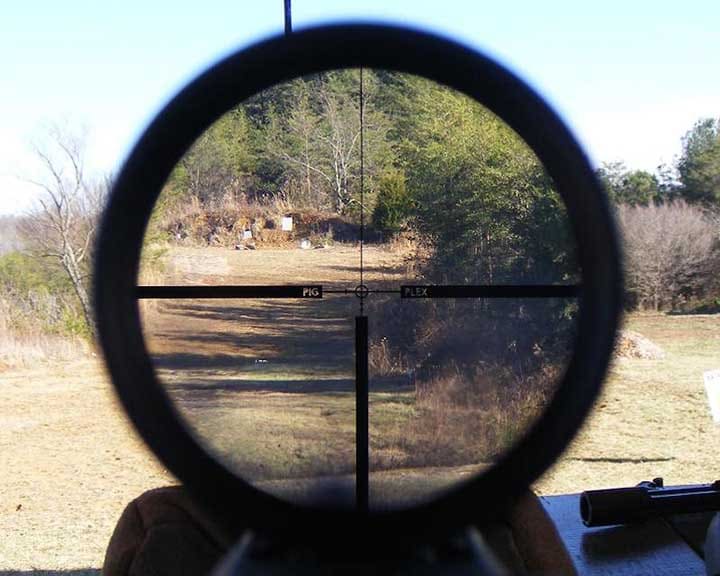
Shopping for a riflescope involves a lot more than simply finding one that looks good on your rifle. There is a whole list of features to consider, and one of the most important is reticle design. There are dozens of configurations to choose from, and understanding the types of scope reticles and the jobs they do best, is the first step in finding the perfect optic for your shooting needs.
Table of Contents
The Most Common Types of Scope Reticles
While it is impossible to list every single reticle type here, we’ve included the most common patterns on the market today.
Basic Crosshairs
This tried-and-true reticle design has been around since the birth of riflescopes. A single vertical line intersected with a single horizontal line, basic crosshairs are easy to use, even for novice shooters. All you do is place the intersection of the lines on your target and send lead downrange.
The reticle provides a wide-open, unhindered sight picture and is a smart choice for eastern deer hunters who rarely need to make long shots.
Duplex Reticle
The Duplex reticle improves on the basic crosshair design. This all-purpose reticle has the same classic perpendicular lines most shooters are familiar with. However, the Duplex reticle has lines that are thicker further from the center of the crosshairs.
This configuration naturally draws the eye to the center of the crosshairs, allowing you to get on target faster. The design is also great for tracking moving targets. Because the bolder sections of the Duplex are highly visible, the reticle is easy to see in thick brush, making it a favorite of hunters.
German Reticles
As with most things, Germans had their own opinions about reticle design. Although German reticles have several configurations, the most common are German #1 and German #4.
The German #1 reticle features a post at the bottom of the reticle that comes to a triangular point in the center of the sight picture. It also has two squared posts on the reticle’s x-axis, protruding from the left and right of the sight picture. The configuration is designed to draw the shooter’s eye to the center.
While the German #1 reticle works well for fast target acquisition, hitting small targets, especially at distance, can be problematic. The reticle’s heavy lines can cover a significant amount of the target. Also, without a crosshair junction, precision aiming can be tricky.
The German #4 reticle closely resembles the Duplex reticle. The major difference is that #4 is missing the Duplex’s bolder line at the top of the crosshair. Like the Duplex reticle, the German #4 is a great option for tracking moving targets, especially in thick woods.
Dot Reticle
Reticles don’t get any more basic than the dot reticle. A simple round mark in the center of the sight picture serves as the aiming point. This type of reticle is commonly found in electronic reflex sights.
Mil-Dot Reticle
A variation of the classic crosshairs, the mil-dot features uniformly spaced dots along each axis. The distance between the centers of two adjacent dots equals one milliradian, which is approximately 3.6 inches at 100 yards (or one yard when you’re looking at a 1000-yard target).
Shooters experienced with mil-dot reticles can use the markings for range estimation and to compensate for bullet drop and wind drift. This type of reticle is useful for shooting long-range targets, whether those targets are paper, steel, varmints, or big game animals.
BDC Reticle
BDC stands for “bullet drop compensation”, and that’s exactly what this reticle is designed to accomplish. A shrewd option for long-distance shooters, the BDC reticle features multiple aiming points that correspond to bullet impact at predetermined distances. The marks are lined up on the main crosshair, with different versions using dots, hash marks, or circles to designate different aiming points for different ranges.
To use the marks effectively, shooters must know the exact distance to their targets. Since bullet trajectory is affected by projectile weight, powder load, and barrel length, matching these factors to the marks on your reticle is just as important.
Modern riflescopes have reticles calibrated for everything from rimfire .22 LR to .50 BMG. Just be sure to match the reticle to your loads, or the marks won’t land you somewhere in the ballpark.
While Mil-Dot scopes are designed for serious long-range shooters, BDC reticles work best for hobbyists and hunters. They are also handy tools for making fast, multi-target transitions.
Christmas Tree Reticle
Christmas tree reticles feature highly detailed MRAD or MOA reference marks for quick, on-the-fly holdovers. The windage and holdover marks get wider toward the bottom of the reticle, creating what resembles a Christmas tree.
While Christmas trees aren’t quite as quick as BDC reticles, they aren’t calibrated for specific cartridges, loads, or rifles. When a scope with a Christmas tree reticle is properly zeroed and the shooter knows their DOPE (data on previous engagements) for their ammo and rifle performance, the shooter can use the marks on the reticle to quickly make accurate shots on multiple targets at a variety of distances.
Christmas tree reticles can seem overwhelming at first glance. There’s a lot of information to process. However, they get easier to understand with practice. Some shooters complain that all that information can clutter up the sight picture, which can be a hindrance when engaging moving targets or tracking game animals.
ACSS Reticle
ACSS is an acronym for “Advanced Combined Sighting System.” This reticle design attempts to provide bullet drop compensation correlated with range estimation, wind, and leads, but in a simpler, less cluttered configuration than the BDC or Christmas tree designs. Once you have properly zeroed the scope, the ACSS reticle allows for quick ranging and adjustments out to 300 yards and provides precision accuracy out to 800 yards.
Final Thoughts
Reticle design is just one feature to consider when shopping for a new scope. Other things to consider include, glass quality, magnification, illumination, turret design, and reticle focal plane. Whichever optic you choose, the best way to improve your shooting is to become familiar with all the features of your optic and how to use them, including the reticle. The best way to gain proficiency with your new firearm/scope combination is to spend some time practicing at the range.

Leave a Reply